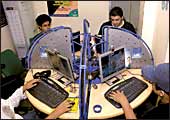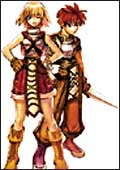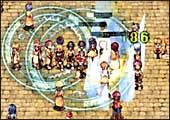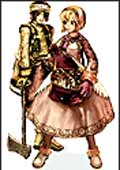 |
| Role-players all: Defending
their castles in fantasyland |
TUESDAY, NOVEMBER 8, 2005
Nariman Point, Mumbai
And
MORROC, GEFFEN, PONTERA,
Rune Midgard
Grey
Drako explores the wilderness of Pontera in Rune Midgard carefully.
He is looking for friends and allies, or people who would like
to hire him for his skills. He may just be a novice, but he is
training to be an assassin and that counts for something in this
world. Still, with no Zenys to his name, he knows he had better
find someone or something soon, even if it is some hapless individual
he can steal from.
Now, Business Today hasn't diversified into
the science fiction and fantasy (SFF) genre, although the business
models of some companies that we do not write about would be a
good source of inspiration should it decide to do so. Rune Midgard
is the setting for an online fantasy quest (a game, in other words,
but more than a game as you shall soon see, Constant Reader) called
Ragnarok (no, although the term is widely used in Mike Mignola's
Hellboy comics, it actually comes from Norse myth and is, as the
phonetics strangely enough seem to suggest, the day of reckoning)
and Grey Drako (actually Grey_Drako) is this writer's online avatar.
 Ragnarok
is one of the world's most popular Massively Multiplayer Online
Role Playing Games (MMORPGs). It is a Korean game (at least, the
company that started it off, Gravity Games is Korean) that is
played by a few million people in some 20 countries across the
world. Like in other MMORPGs, players dedicate a few hours of
their lives every day to Ragnarok, so we are speaking about some
serious manpower here. The game has been around in India for a
year, having been launched by Level-Up India, the Indian arm of
a Philippines-based games publisher, and, according to Venkat
Mallik, the company's Managing Director, already boasts a few
thousand players. Ragnarok
is one of the world's most popular Massively Multiplayer Online
Role Playing Games (MMORPGs). It is a Korean game (at least, the
company that started it off, Gravity Games is Korean) that is
played by a few million people in some 20 countries across the
world. Like in other MMORPGs, players dedicate a few hours of
their lives every day to Ragnarok, so we are speaking about some
serious manpower here. The game has been around in India for a
year, having been launched by Level-Up India, the Indian arm of
a Philippines-based games publisher, and, according to Venkat
Mallik, the company's Managing Director, already boasts a few
thousand players.
RPGs (Role-Playing Games) or MMORPGs are
a global phenomenon. Unlike computer or console games where the
maximum number of players is restricted to eight, these can accommodate
thousands, even millions of players, playing together, collaborating
sometimes, competing against each other at times. They are not
as violent as multi-player shooters and do not have as much sexual
content (they do have some) as some stand alone console games,
and each player has an online avatar, with some pre-defined powers.
MMORPGs are the craze in some markets. In Korea, for instance,
an estimated 10 million people, a fifth of the country's population,
play them everyday, half of this number playing Lineage: The Blood
Pledge, the world's most successful MMORPG. And in China, internet
penetration has been driven by a home-grown role-playing game,
The World of Warcraft, which has some 3.5 million players.
 |
 |
| Virtual reality: Level-Up
India's Mallik hopes to go pay successfully |
The world over, role-playing games make their
money from subscriptions that range from $7-20 (Rs 315-900) a
month. Ragnarok India (www.ragnarok.co.in) is free right now,
but Mallik says, "We will eventually have to go paid; while
we are prepared to take a hit in numbers we are sure that the
game will continue to attract players (even after that)."
All this time, Drako has been progressing
through Midgard; he is now in Geffen (classified netherland),
and is heading for a marketplace, but this writer has to know
just who plays Ragnarok and why, so he heads off to a Reliance
WebWorld in Bandra.
WEDNESDAY, NOVEMBER
9, 2005
Reliance WebWorld, Bandra, Mumbai
Every Wednesday
and Saturday, between six and eight (p.m.) we have something called
a castle siege," says Mallik. That's when guilds, essentially
teams of players who have 'captured' castles, defend them against
attacks from other guilds that try to capture them.
 The
cybercafe is full of 10 to 18-year olds, all part of a guild calling
itself DeathRow (15 of the 20 terminals at the café have
been taken over by the guild). An employee of the café
claims that some of these kids are regulars, there at anytime
between 10.00 a.m. and 8.00 p.m., the café's working hours,
and playing the game. It's worse in WebWorlds in Pune, he adds.
"There, the entire store is taken over by these Ragnarok
guys all day." The
cybercafe is full of 10 to 18-year olds, all part of a guild calling
itself DeathRow (15 of the 20 terminals at the café have
been taken over by the guild). An employee of the café
claims that some of these kids are regulars, there at anytime
between 10.00 a.m. and 8.00 p.m., the café's working hours,
and playing the game. It's worse in WebWorlds in Pune, he adds.
"There, the entire store is taken over by these Ragnarok
guys all day."
The café is noisy: super-charged adolescents
are hollering out instructions, all the while typing madly (all
RPGs require players to type instructions on how their characters
should respond).
"Do your parents know you are here?"
I ask a random sub-teen.
"Are you mad?" he shoots back.
"They'll kill me if they know I am here."
"How much do you spend at the cybercafe?"
"Me, I'm not that regular, I spend around
Rs 1,000 a month (the café charges 50-90 paise a minute
for high-speed internet access for gaming); but that's not as
much as he (points to a 10-year-old sitting before another terminal
and lost, for all practical purposes, in Rune Midgard) does; he
spends Rs 3,000 a month."
"So, why don't you play this from home?"
 "Most
of us have only dial-up connections; then, there are parents;
damn it, the TCS are attacking..." "Most
of us have only dial-up connections; then, there are parents;
damn it, the TCS are attacking..."
And he goes back to a world where a guild
called the ThunderCats (TCS) is attacking a castle controlled
by DeathRow.
Level-Up has alliances with Reliance WebWorld
and Sify iWay and the game is pre-installed on most machines at
these cafés, allowing players to simply log-on to the fantasy
world. Mallik claims some of the players are older and that around
30 per cent are women. He adds that most players do not have great
inter-personal skills in the real world and use their online avatars
to make friends and build relationships, one reason why he thinks
the marriage patch, Level-Up will soon introduce in Ragnarok (It
will, he says "help people have virtual relationships".)
will be a hit. Hey, maybe Drako can get lucky at least in the
virtual world.
|





 Ragnarok
is one of the world's most popular Massively Multiplayer Online
Role Playing Games (MMORPGs). It is a Korean game (at least, the
company that started it off, Gravity Games is Korean) that is
played by a few million people in some 20 countries across the
world. Like in other MMORPGs, players dedicate a few hours of
their lives every day to Ragnarok, so we are speaking about some
serious manpower here. The game has been around in India for a
year, having been launched by Level-Up India, the Indian arm of
a Philippines-based games publisher, and, according to Venkat
Mallik, the company's Managing Director, already boasts a few
thousand players.
Ragnarok
is one of the world's most popular Massively Multiplayer Online
Role Playing Games (MMORPGs). It is a Korean game (at least, the
company that started it off, Gravity Games is Korean) that is
played by a few million people in some 20 countries across the
world. Like in other MMORPGs, players dedicate a few hours of
their lives every day to Ragnarok, so we are speaking about some
serious manpower here. The game has been around in India for a
year, having been launched by Level-Up India, the Indian arm of
a Philippines-based games publisher, and, according to Venkat
Mallik, the company's Managing Director, already boasts a few
thousand players. 

 The
cybercafe is full of 10 to 18-year olds, all part of a guild calling
itself DeathRow (15 of the 20 terminals at the café have
been taken over by the guild). An employee of the café
claims that some of these kids are regulars, there at anytime
between 10.00 a.m. and 8.00 p.m., the café's working hours,
and playing the game. It's worse in WebWorlds in Pune, he adds.
"There, the entire store is taken over by these Ragnarok
guys all day."
The
cybercafe is full of 10 to 18-year olds, all part of a guild calling
itself DeathRow (15 of the 20 terminals at the café have
been taken over by the guild). An employee of the café
claims that some of these kids are regulars, there at anytime
between 10.00 a.m. and 8.00 p.m., the café's working hours,
and playing the game. It's worse in WebWorlds in Pune, he adds.
"There, the entire store is taken over by these Ragnarok
guys all day."  "Most
of us have only dial-up connections; then, there are parents;
damn it, the TCS are attacking..."
"Most
of us have only dial-up connections; then, there are parents;
damn it, the TCS are attacking..."